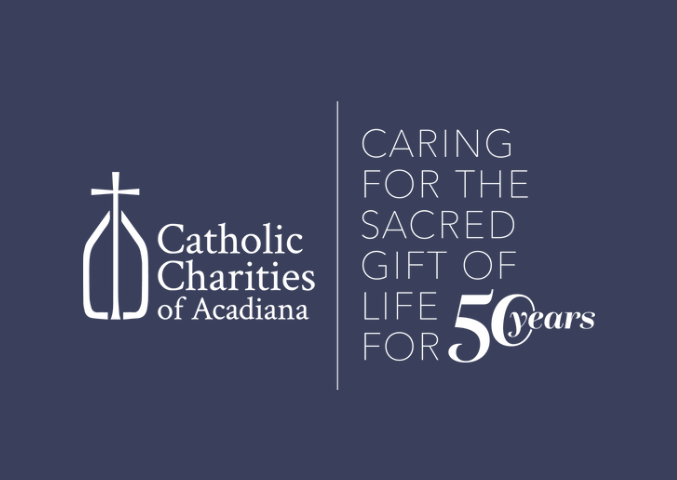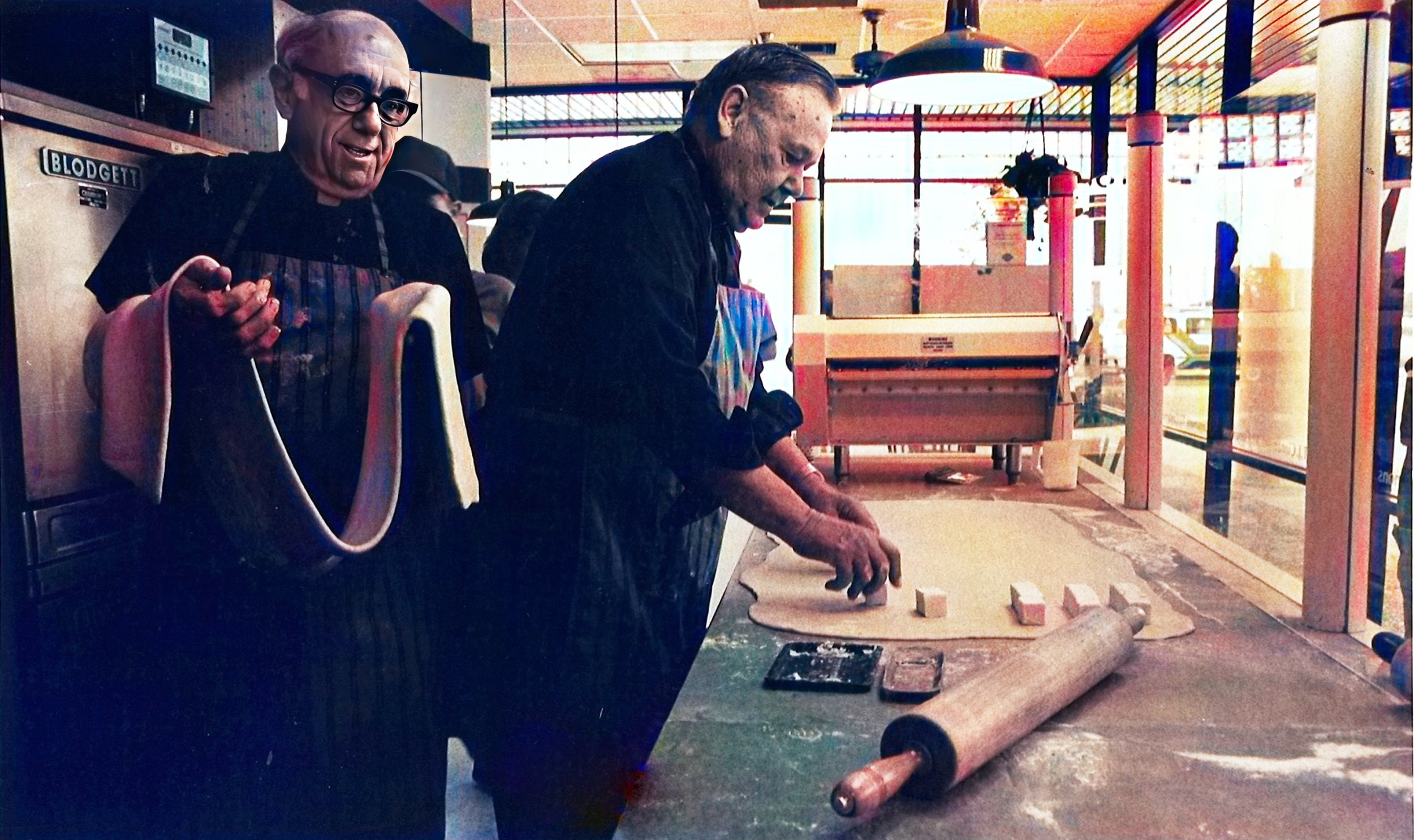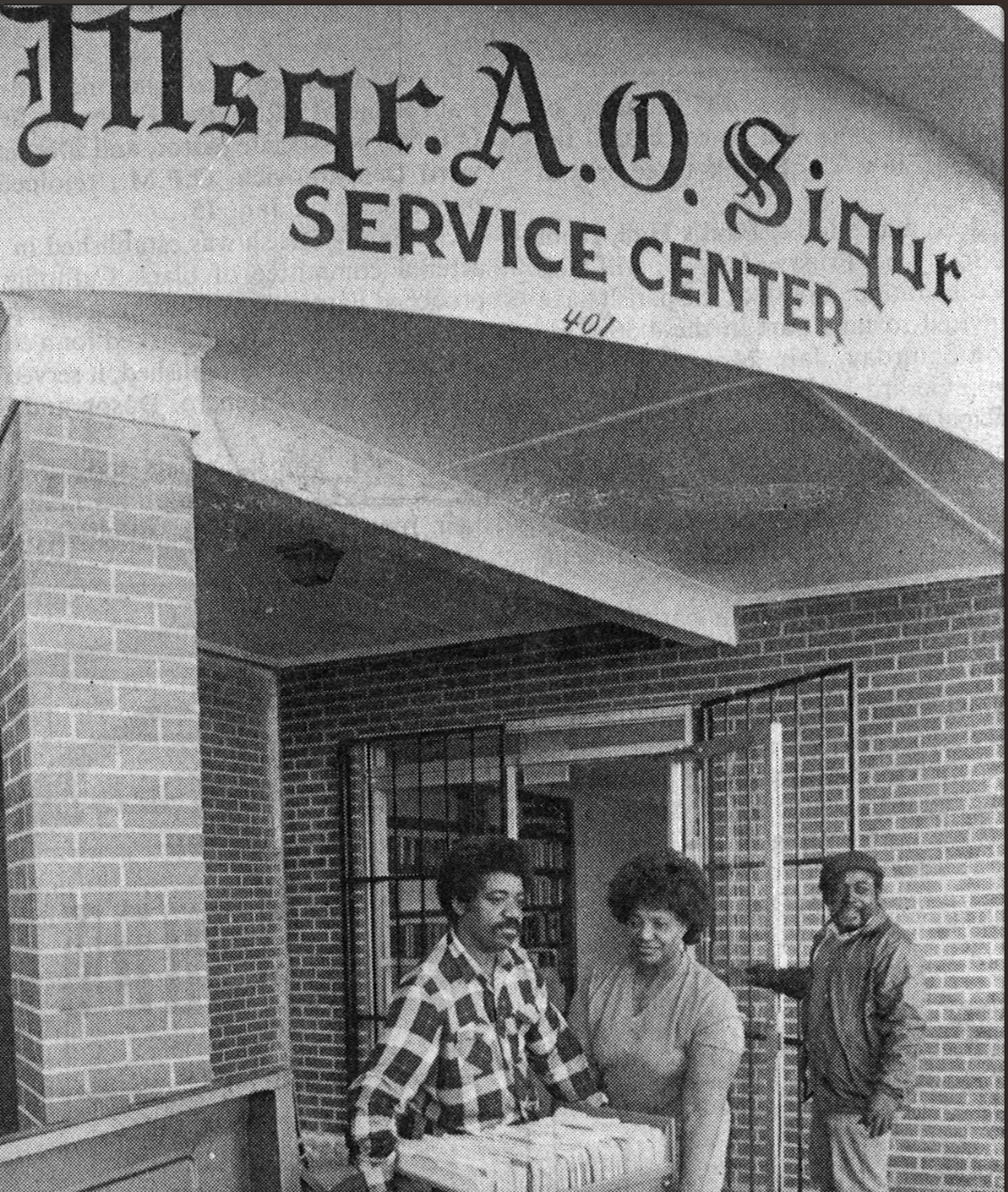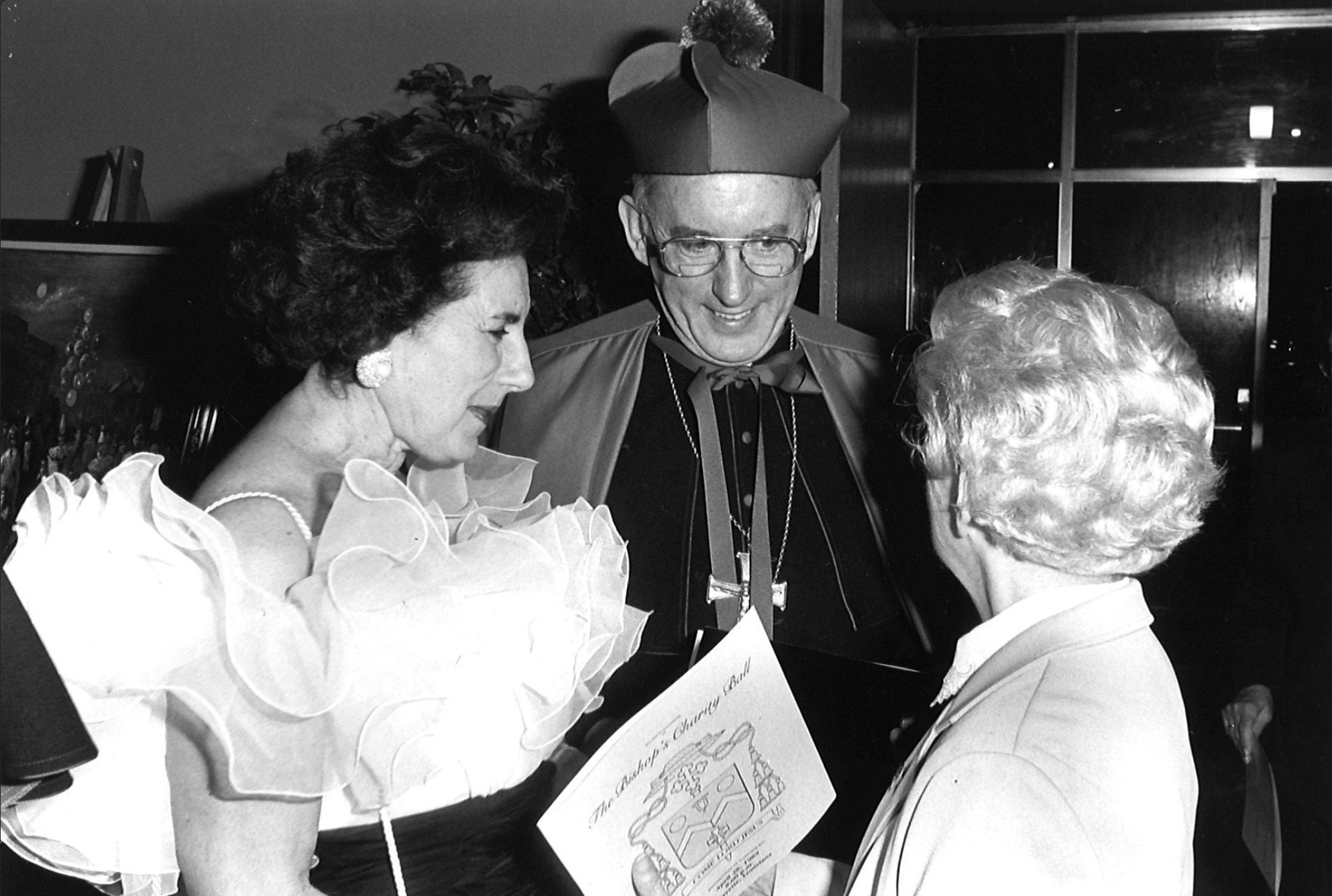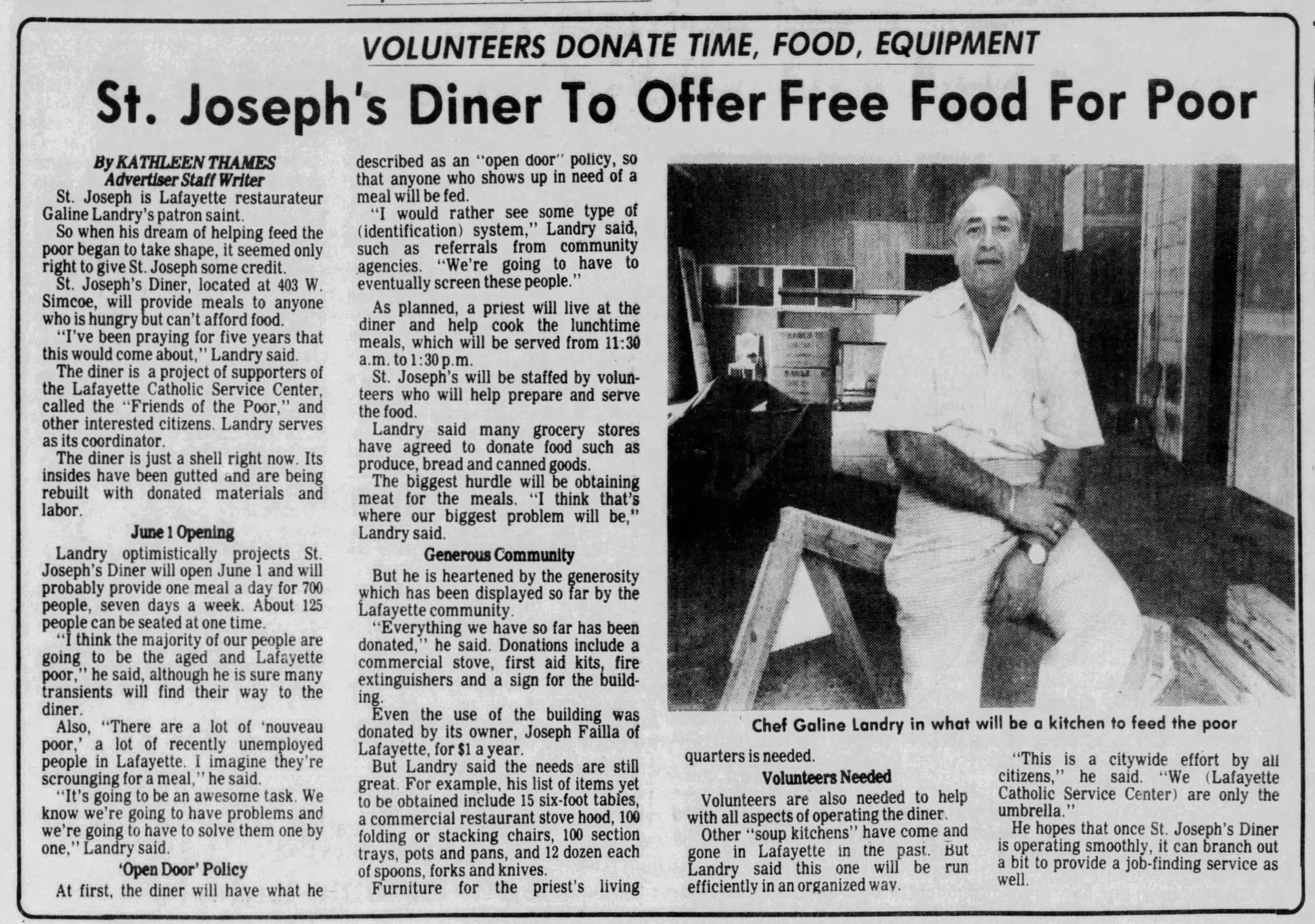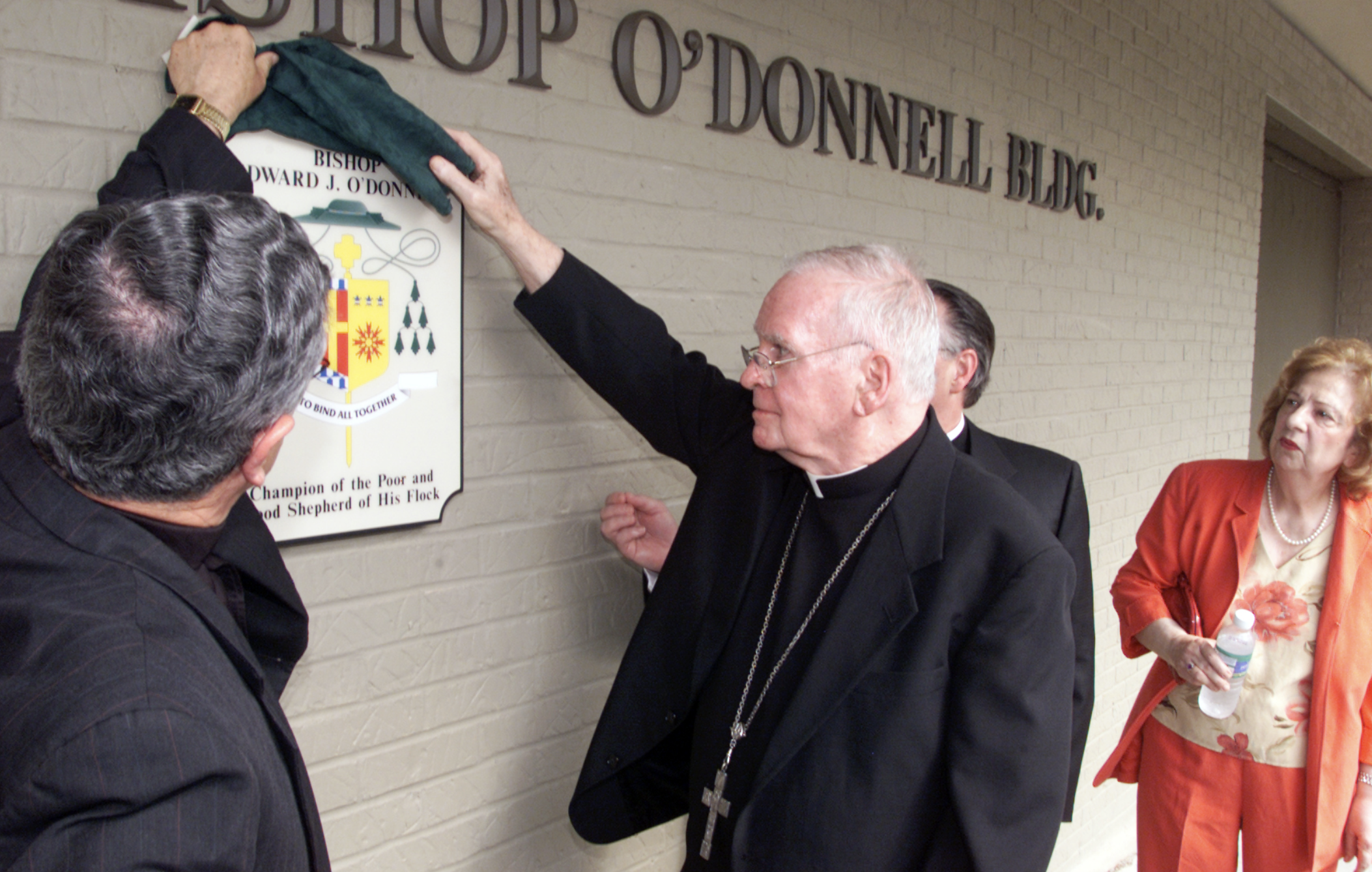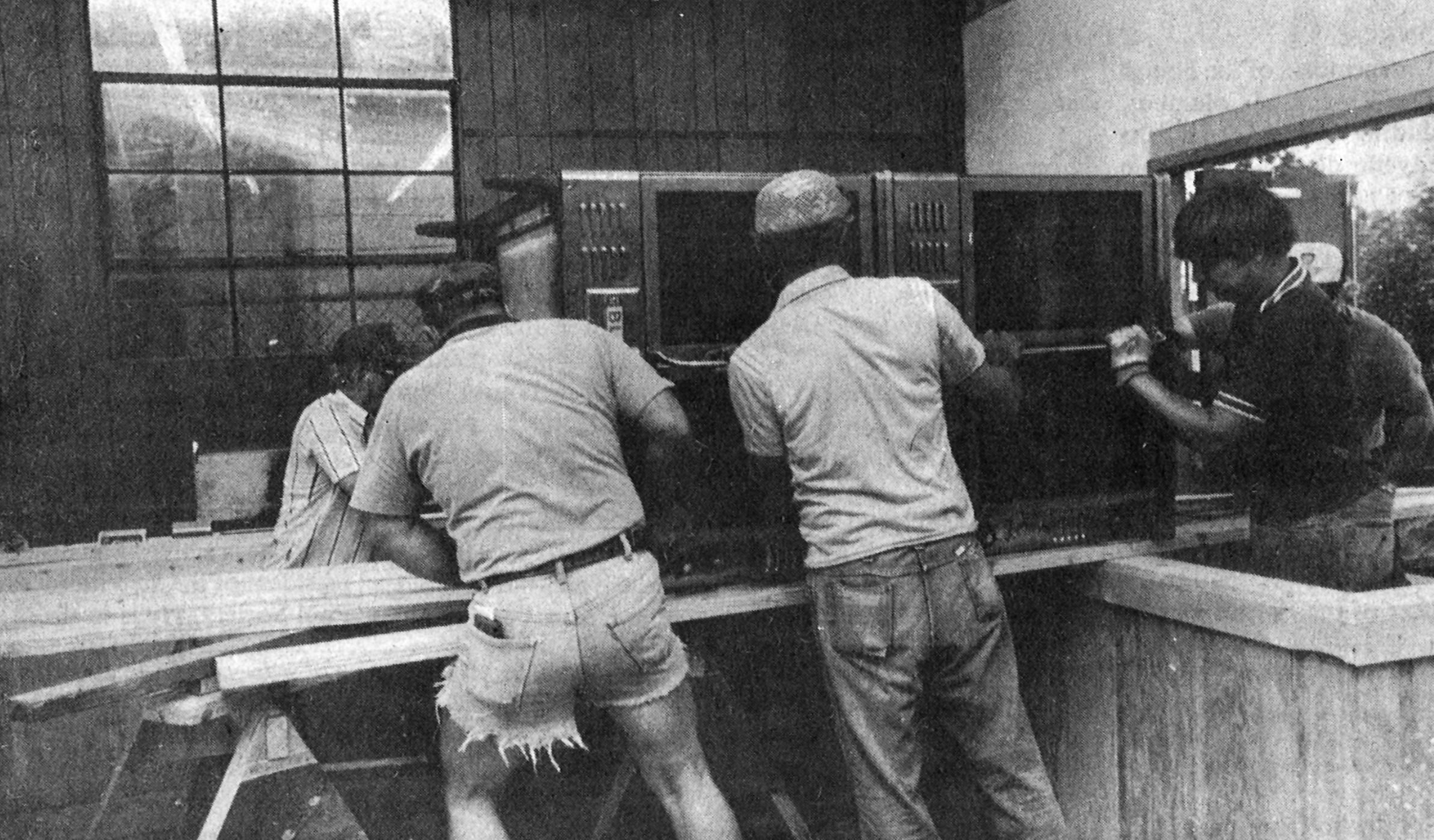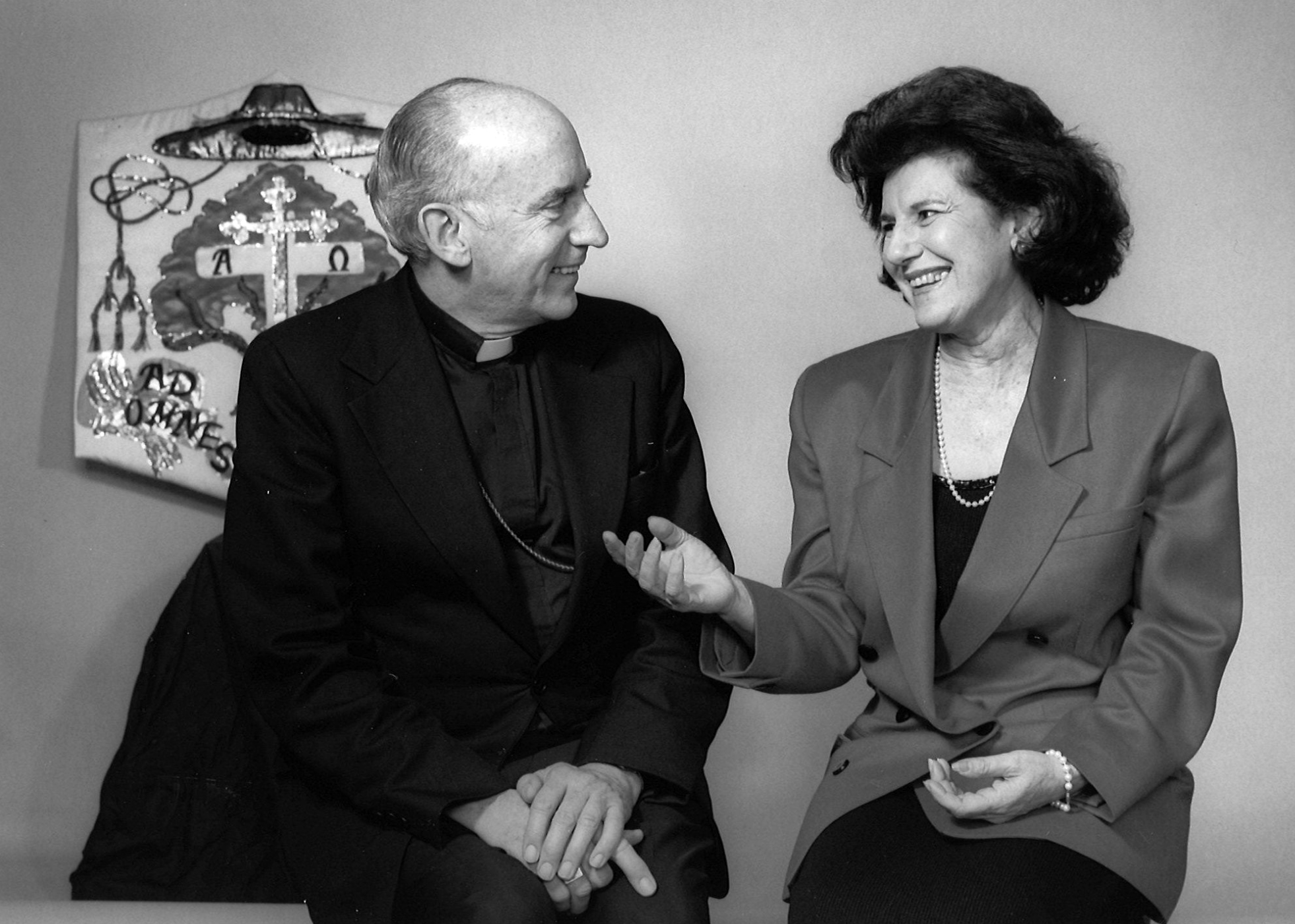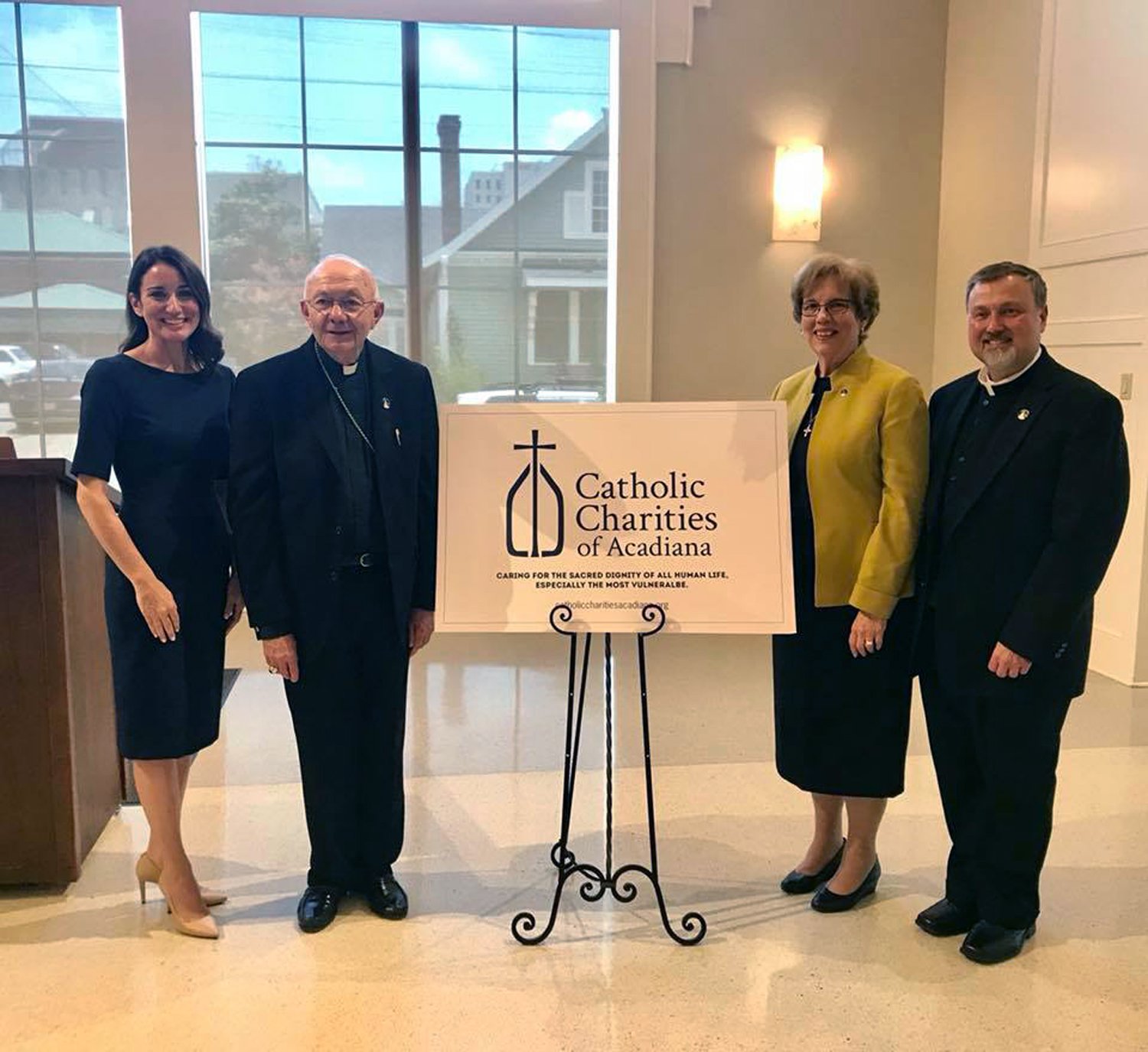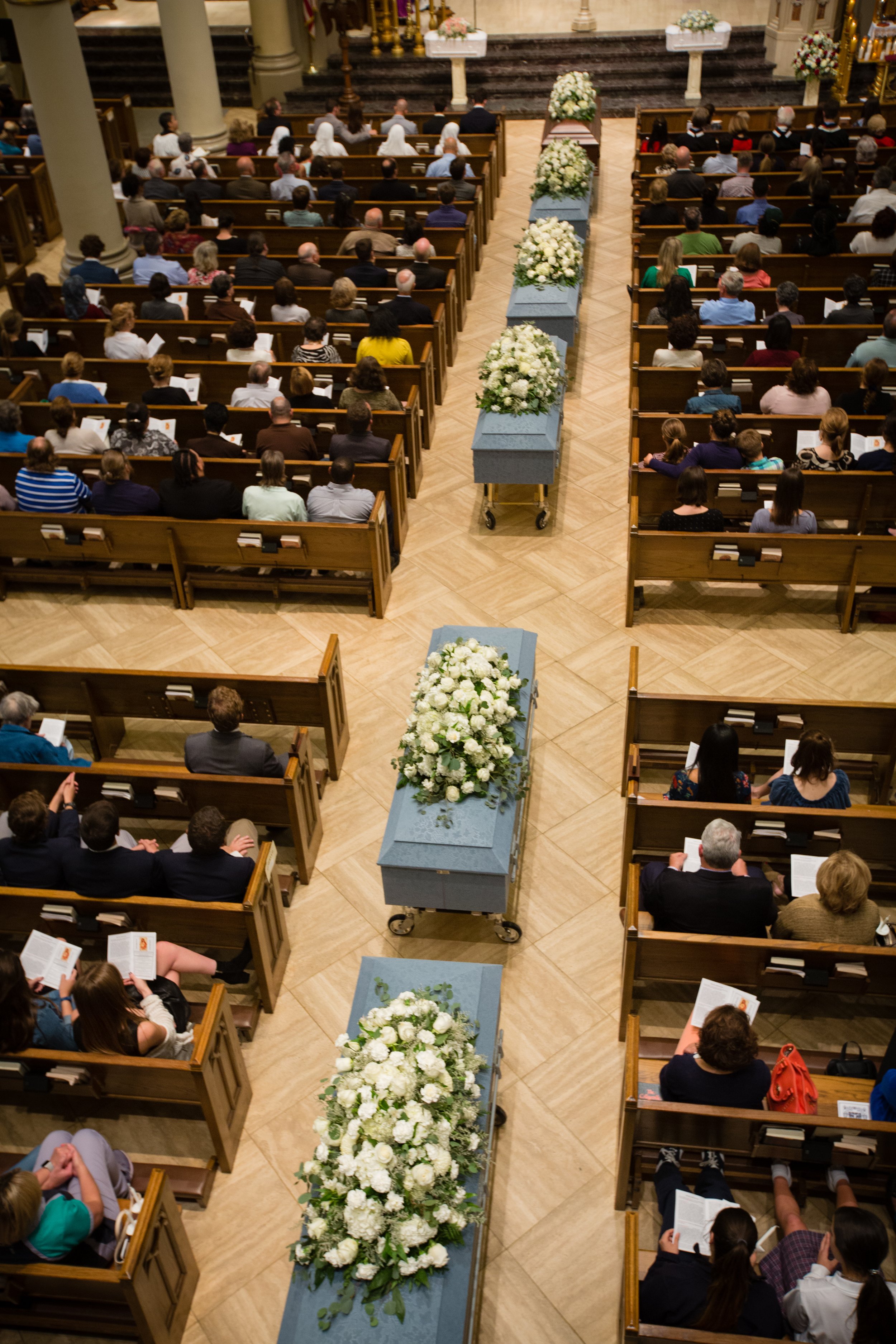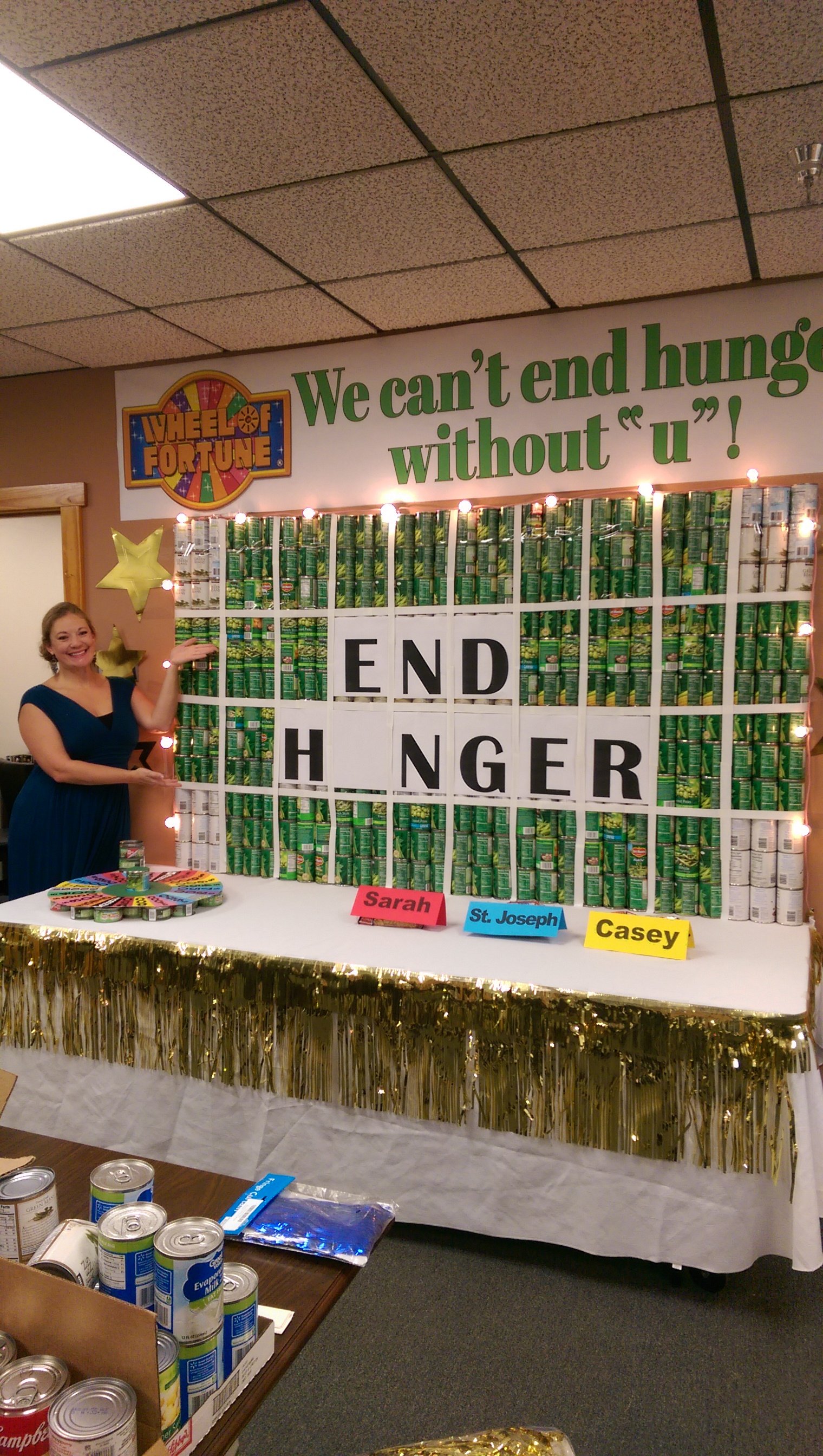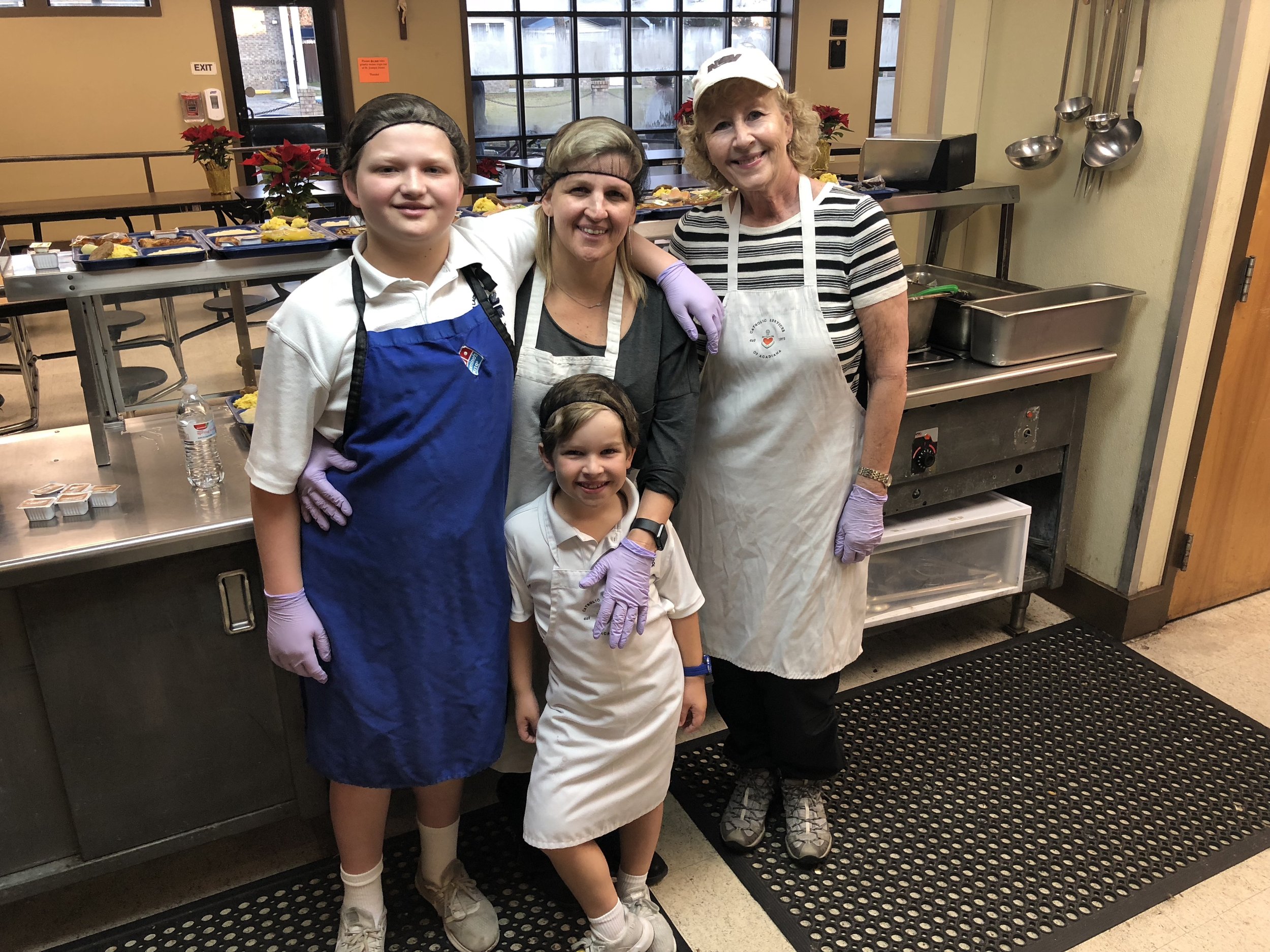A Legacy of Compassion: Catholic Charities of Acadiana Celebrates 50 Years
"And the king will say to them in reply, 'Amen, I say to you, whatever you did for one of these least brothers of mine, you did for me.'" - Matthew 25:40
In the early 1970s, local civic and religious leaders were troubled by the growing number of people experiencing hunger, suffering prolonged unemployment, and seeking assistance. A more comprehensive and big-picture approach was needed to tackle the ever-increasing challenges. Bishop Gerard L. Frey called upon the Catholic community to set up service centers throughout the Diocese to better assist those experiencing hardship.
One of the first to answer the call was Rev. Msgr. Jude Speyrer, founding pastor of Our Lady Queen of Peace Parish in Lafayette, LA. He asked Mrs. Luci St. Julien, a member of the OLQP congregation, to help lead a new organization they called the "Lafayette Catholic Service Center" (LCSC). The official-sounding name belied the extraordinary humility of its origins: Mrs. St. Julien set up shop at a three-legged table with just a chair and a telephone, sharing a small building that also housed the OLQP pastor's office. From that first location at 1400 N. University, to its current location at the corner of West Simcoe and St. John, the organization has grown to provide a broad array of essential services to those in need.
By the late 1970s, Lafayette Catholic Service Center was a hub for various programs and charitable efforts. It offered everything from emergency financial help for families (rent/utilities), adult education/GED classes, summer programs for children from nearby Truman Elementary, and even dental services. Responding to the community's needs, LCSC continued to grow under that same small, cramped roof. By the 1980s, it fed up to 300 people a day, stocking essentials for babies, donated clothes, and even a bit of furniture. It did all of this with a shoestring budget made up of donations from Lafayette City Deanery Catholic churches and private contributions from businesses and individuals.
Then they cried to the LORD in their trouble, and he delivered them from their distress - Ps:107:6
Alexander Octave Sigur was born in 1921 in Crowley. He earned a degree in canon law from the Angelicum in Rome and would go on to serve in various roles throughout his long career. Known for his gregarious manner, he rose quickly through the ranks, taking on many different functions throughout his long career. After serving as rector of Notre Dame Seminary in New Orleans for four years, he was summoned back to Lafayette by Bishop Frey in 1974. This marked the beginning of Monsignor Sigur's two decades of transformational leadership in Acadiana, culminating in an agency that still bears his name and a legacy that continues to inspire to this day.
By the early 1980s, more groups and individuals were looking for ways to help those experiencing unemployment, poverty, homelessness, and other challenges. Monsignor Sigur founded a group called "Friends of the Poor" in 1982 that would meet monthly to discuss local problems and brainstorm solutions. This ecumenical group led by Monsignor Sigur, then vicar of the Diocese of Lafayette, included many prominent citizens who saw the need for a modern-day "soup kitchen." Inspired by the Great Depression-era version, it would offer the hungry a hot meal and a caring spirit. The group established a planning committee to make this vision a reality, and they discovered that a great deal of food was going to waste at local restaurants that could be better used to feed the hungry. They recruited local businesses and restaurants to provide supplies and donations, secured a facility (a former auto-body shop donated by the Failla family), and began work to renovate it with donated materials and labor. Local restaurateur Galine Landry, one of the planning committee leaders, chose the name "St. Joseph Diner" after his patron saint. Modeled after the Ozanam Inn in New Orleans, the new diner officially opened on August 15, 1983, at 403 W. Simcoe. On the first day, the Diner served 15 people. By the end of the year, the Diner had served more than 10,000 meals to the hungry of Lafayette.
One year later: the Diner was serving an average of 175 meals per day, though it has also been as high as 250. Mrs. Peggy Crews is the only employee (part-time), and volunteers do all staffing. From the Daily Advertiser, August 21, 1984: "A civil engineer donates his time to make plumbing and electrical repairs. A pediatrician washes dishes and holds down an important position on the serving line. An ex-grocer, who currently is a contractor, serves as the foreman responsible for all activities involving manual labor. An oilfield equipment salesman earns a sore back by washing dishes over a sink that is too low."
By 1986, after 13 years of working in cramped quarters at North University, LCSC finally moved into a newly renovated former produce market (also donated by the Failla family) next to St. Joseph Diner on W. Simcoe. It was named the Monsignor Sigur Service Center (MSSC) in recognition of his dynamic leadership and unwavering vision. Mrs. St. Julien continued to serve as its director until retiring in 2005. At the time, the MSSC offered emergency financial assistance, clothing, and food to those in need. Volunteer dentists performed extractions for $5. With the crash in oil prices, more and more people had found themselves suddenly unable to make ends meet. It was a trying time for many in Acadiana.
"For I was hungry and you gave me food, I was thirsty and you gave me drink, a stranger and you welcomed me…" - Matthew 25:35
When the Lighthouse men's shelter on S. Pierce St. burned down in May of 1987, the team behind St. Joseph Diner and the MSSC stepped up to fill the gap. They managed to secure a temporary location to house the 24 men (a vacant convent on Cherry St.) until a permanent replacement shelter could be established. A $22,500 federal grant helped launch the St. Joseph Shelter for Men, officially dedicated in February 1988. With the help of the Boustany family, the permanent facility, located at 425 St. John, accommodated up to 30 men per night. In a quote from The Daily Advertiser, 80% of those experiencing homelessness had previously worked in the oilfield for many years. Some were even former business owners.
"The services were born of need and community support ... 'A few years ago we never dreamed we'd have a Men's Shelter,' he says. 'We never dreamed a diner would be a necessity ... It opened five years ago, and we've never missed a day, never missed food.'... 'There are two levels of need really. One is serving the immediate needs of these people, which is mostly what we do. The other is getting to the root system, improving their quality of life so they can find employment, not be totally dependent.' –Msr. Sigur (April 29, 1988, Daily Advertiser)
In June of 1989, Bishop Frey asked Sister Patricia Cairns to take over as executive director for Lafayette Catholic Service Centers. At the time, LCSC comprised the Monsignor Sigur Service Center, St. Joseph Shelter, St. Joseph Diner, St. Joseph Family Shelters, and the St. Joseph Thrift Store. Cairns had a background in sociology and previously served as executive director of the Catholic League for Religious and Civil Rights, a national organization based in Milwaukee.
"I think it's a growing national problem felt in every community and Lafayette is among the many communities feeling the crunch." The area's high unemployment rate contributes greatly to the problems, Cairns said, noting that many of the people using the center's services are out of work and cannot find jobs. She also stated that it is not only individuals who find themselves homeless but also entire families. Cairns cited national figures, which estimate that there are at least 19 million Americans one missed paycheck away from the street.
"One of the things we're trying to develop here is the spirit of the place. And that spirit is hospitality. We're trying to establish the principle that no one will be turned away from here that is in need of food or clothing. We try to greet each person who comes into the center with a smile. We want them to feel at home. We want to create and maintain an environment where all persons can feel a sense of personal regard"
–Daily Advertiser (September 10, 1989)
At the time, Lafayette Catholic Service Centers provided 2,300 families with groceries each year, fielded 3,400 calls for help, and served 11,000 lunches (via St. Joseph Diner). Three volunteer dentists assisted more than 177 patients at the Sigur Center a year. By 1993, the Monsignor Sigur Service Center was celebrating its 20th anniversary of serving the community. The organization had been the foundation for everything that grew from it: at that point, this included eight separate programs dedicated to helping those in need.
After a lifetime of service to others, Monsignor Sigur passed away in 1997. From a news article at the time: "Citing Monsignor Sigur's many activities and accomplishments, Bishop Edward O'Donnell noted 'His name will be in large writ on every page of the history of the Diocese. It will be a long time before we see his like again.'" That year, St. Joseph Diner served 147,580 meals, and 66,840 people received food bags through the Monsignor Sigur Service Center and New Life Center, a former shelter for women and children located in downtown Opelousas.
As the decade ended, changes at the national level began to appear locally. Due to massive cuts to federal welfare programs in 1999, many people suddenly found themselves unable to keep up with day-to-day expenses and sought help from local agencies. It was an increase Lafayette Catholic Service Centers saw coming. A headline from the Daily Advertiser on January 2, 1999, read: "Area service providers waiting for the impact: Social Service warns hard time is coming." A former LCSC Executive Director told the paper: "We'll go very quickly from people just looking for food at the Sigur Center and the Diner and other food pantries in January and February to people needing shelter by the summer." He said that the state had warned him that 20-30 percent of those cut from welfare rolls would end up experiencing homelessness. In response, LCSC and other local service providers took steps to expand their shelter capacity and support services.
By March of the following year, the Monsignor Sigur Service Center had relocated to its present location in the Boustany building complex. The site was within walking distance for many single-parent households and older adults, and plans included eventually providing health clinic services to area children and families. For over 20 years, a reliable source of funding for the organization was the Bishop’s Charity Gala envisioned together by Msgr. Sigur and Madlyn Boustany Hilliard. Madlyn has given reverence to all the work of Msgr. Sigur did for those experiencing poverty by saying, “he showed us what it was to serve the poor and how much the poor needed.” In the early 2000’s, this event transitioned to an in-home fundraising event called Opus Christi Magnum, Latin for “The Great Work of Christ.”
In the winter of 2001, record-breaking cold weather and all-time high natural gas prices left many Acadiana residents struggling to pay their utility bills. According to Mrs. St. Julien, the MSSC gets "about 200 calls for gas and light bill help, but in the past four weeks, we have had at least 1,000 phone calls." Both then and now, the MSSC helps people in need, whether it's with utility bills, funeral expenses, or even bus fare to reconnect with natural support systems.
'“But a Samaritan traveler who came upon him was moved with compassion at the sight. He approached the victim, poured oil and wine over his wounds and bandaged them. Then he lifted him up on his own animal, took him to an inn and cared for him.” - Luke 10:33-34
As the Acadiana region continued to grow through the early aughts, the twin disasters of Hurricane Katrina and Rita lurked on the horizon. A new leader arrived in 2005 to help navigate the troubled waters to come. After years spent abroad doing missionary work, Kim Boudreaux felt God calling her home. "I began volunteering at St. Joseph Diner and just fell in love with the organization's work," said Boudreaux. In 2005, she was named executive director of LCSC, which included St Joseph Diner, Msgr. Sigur Center, St. Joseph Shelter for Men, St. Joseph Thrift Store, Promised Land Transitional Housing, New Life Center, New Life Center Daycare, and New Life Center Thrift Store. Her energy and enthusiasm for the work would prove especially valuable in the coming years, as new challenges and opportunities would emerge.
"The best part of her job? 'Having the daily opportunity to provide corporal works of mercy that we as Christians are called to do is a privilege. And witnessing the compassion of the community…who show such boundless mercy to those we serve.'"
With Boudreaux at the helm, Lafayette Catholic Social Service stepped up to assist with disaster recovery and distribution efforts following Hurricane Katrina but found itself needed even more urgently in the wake of Hurricane Rita. Because of the latter storm's widespread devastation in the Acadiana region, LCSC coordinated with FEMA, the Red Cross, United Way, NGOs, and other religious groups working in the area. Hurricanes Ike and Gustav in 2008 added to the natural disaster toll on south Louisiana, further illustrating the need for disaster response leadership within the community.
In 2007, it was identified that 40% of the men in St Joseph Shelter were veterans. St. Michael Center for Veterans was established as an emergency and transitional housing program for up to 12 Veterans who are experiencing homelessness. The program was later expanded to include female veterans and families. Services include shelter, essential support, access to mainstream services, education, employment, and housing placement, operating in conjunction with the VA Medical Center in Alexandria, Louisiana.
In 2010 leadership was painfully aware of the need for a new facility for St. Joseph Diner. After 27 years in its original location, St. Joseph Diner moved into its new home three blocks away, in the same Boustany building complex that housed other organizational programs. The new space was roughly the same size but configured far better for the Diner's needs. It served an average of 175 meals per day (as always, 364 days per year) plus breakfast and supper for the men's and veterans' shelter residents. On weekdays, meals were delivered to the homebound, and over 4,000 bread and commodity boxes were distributed yearly to low-income seniors. "'They now have a place they can call their own, that's new, properly designed and properly equipped,' said Lafayette Sheriff Mike Neustrom, committee chairman of the original diner in 1983. 'They're able to do better at what they do.'" (Daily Advertiser, June 19, 2010.)
In 2012, CSA responded to the critical need of offering a hygiene facility for those who were unsheltered in Lafayette. Named after Our Lady Star of the Sea: the Stella Maris Center, was made possible through generous lead contribution from the Lourdes Foundation and support from family foundations, and churches. The Stella Maris Center filled a critical need: giving individuals a place to shower, use the restroom, do laundry and take care of other basic hygiene needs. The program also connects its patrons with additional resources to assist them in their effort to regain housing.
In 2012, CSA established a housing program to work with individuals experiencing chronic homelessness to secure affordable permanent housing. As best practices have evolved, so has the program. Now called Permanent Supportive Housing, the approach focuses on securing housing for the client and providing wrap-around services to help sustain independence.
In 2014, in recognition of the expanded role played by Lafayette Social Service Center throughout the local region, the organization's name was changed to Catholic Services of Acadiana (CSA).
In 2018, Catholic Services of Acadiana opened the doors to The Emily House, a program serving the specific needs of families experiencing homelessness, replacing the 25-year-old New Life Center in Opelousas. Reflecting best practices for addressing homelessness, the Emily House works to ensure that experiences of homelessness are rare and brief. The sheltering program services focus on rapidly returning families to permanent housing, with a goal of stabilization through intensive and personalized case management services after housing placement.
2018 would mark yet another significant turning milestone for the organization. In partnership with the Diocese of Lafayette and with the approval of Bishop Douglas Deshotel, Catholic Services of Acadiana became Catholic Charities of Acadiana (CCA). The name change seemed small, but it reflected a new, enhanced role for the organization. It would transfer programs previously managed by the Diocese, including its Office of Immigration Services and the Deaf Action Center. It coincided with a focus expansion toward serving the eight civil parishes covered by the Diocese of Lafayette.
More growth was still to come. In July of 2019, Catholic Charities of Acadiana merged with FoodNet Food Bank, a local food pantry founded in 1987 by Marcelle Citron, a well-known Lafayette philanthropist. At the time, Foodnet was distributing about 300,000 pounds of food each year, and the goal was for FoodNet to supply food pantries throughout the eight civil parishes where CCA operates.
That same month, Catholic Charities also merged with Rebuilding Together Acadiana, a local affiliate of the leading national nonprofit working to preserve affordable home ownership. As a program of CCA, Rebuilding Together Acadiana mobilizes volunteers and leverages donated or discounted building materials to complete repairs at no cost to homeowners.
Catholic Charities of Acadiana’s Legal Services provides comprehensive, low-cost legal aid services to newcomers to this country, allowing them an opportunity to contribute and participate more fully in our communities.
The Deaf Action Center works with Deaf, Deaf-Blind, and Hard of Hearing people to provide sign language interpreting through a network of qualified sign language interpreters.
In August, only four years since south Louisiana had experienced catastrophic flooding, Hurricanes Laura and Delta devastated Lake Charles and the greater southwestern portion of the state, including parts of Acadiana. When the call came, Catholic Charities of Acadiana’s Disaster Response and Rebuilding Together Acadiana had only recently finished work on their last flood-damaged home. The two groups soon responded seven days a week to provide tarps, debris removal, muck-outs, and other types of rebuilding. A partnership that lasted during the pandemic was formed with Second Harvest Food Bank; St. Joseph Diner prepared meals for the many individuals and families who have evacuated to the area and distributed food bags throughout the region.
Almost a year later, Hurricane Ida wreaked havoc on southeast Louisiana, leaving a wide path of destruction. Catholic Charities of Acadiana assisted in the aftermath, coordinating leadership and more than 10,000 meals for Terrebonne, Lafourche, and Grand Isle residents. CCA arranged volunteer crews for several weeks, deploying over $200,000 and immediate response supplies and efforts, such as essential relief cards, mucking and gutting, feeding, gasoline delivery, and roof tarping.
Then I heard the voice of the Lord saying, “Whom shall I send? Who will go for us?” “Here I am,” I said; “send me!”
This year marked a partial return to normalcy. On August 1, 2022, in-person dining returned to St. Joseph Diner. Through FoodNet Food Bank, Catholic Charities of Acadiana is continuing to deliver food bags in rural areas of Acadiana. COVID-era funding is drying up now, though the needs in our community continue. Some of CCA's most essential programs remain 100% donor-funded, including emergency sheltering, St. Joseph Diner, FoodNet Food Bank and Immigration. While the organization continues to provide critical services to the most vulnerable in society, funding from state and local governments adds up to only a small percentage of the total budget. That means that after 50 years of serving the community, Catholic Charities of Acadiana continues to rely on the generosity of local individuals, churches, groups, and businesses for its ongoing support.
"We will never waver in our commitment to care for the most vulnerable in our community. Natural and situational disasters create barriers for those experiencing poverty; these barriers can seem insurmountable. As long as there is suffering among the disconnected, isolated, and alone in Acadiana, we will stand in solidarity and work toward their common good." - Kim Boudreaux


